Revised 27 June 2022
Accepted 3 February 2023
Available Online 14 March 2023
- DOI
- https://doi.org/10.55060/s.atssh.230306.006
- Keywords
- Discipline competition
Innovation and practice ability
Cultivation of talents - Abstract
In order to meet the requirements of modern 2035 education in China, there is a must to deepen the reform of innovation and entrepreneurship education in colleges and universities, better realize the integration of “expertise and innovation”, and explore ways to improve the innovative practice ability of college students based on discipline competitions. In the implementation of the subject competition, it is necessary to set up “specialty” to integrate characteristic demonstration courses and specialized courses, consolidate the students' professional basis and make them “strong base”. It is also necessary to develop rich and colorful student science and technology associations, cultivate students' interest in scientific research and innovation, and make students “energetic”. Through the course of ideological and political education, we can cultivate Lide Shuren's Chinese vision, rigorous and realistic scientific spirit, and the national mood of serving the country with science and technology, in order to make students “grow up with responsibility”. Finally, the four levels of improvement of college students' innovative practical ability of “knowledge-ability-literacy-responsibility” are realized, the innovative and Entrepreneurship Talent Training mode is constructed, and the innovative talent training mechanism is improved.
- Copyright
- © 2023 The Authors. Published by Athena International Publishing B.V.
- Open Access
- This is an open access article distributed under the CC BY-NC 4.0 license (https://creativecommons.org/licenses/by-nc/4.0/).
1. INTRODUCTION
After entering into the 21st century, the higher education develops rapidly in China, but there are still problems in theory depth and practice teaching ability. Traditional teaching methods are outdated and lack of individualized teaching methods; The teaching staff “emphasizes scientific research” and “emphasizes practice”, and lacks project practice experience; The “one-sided” and “closed” evaluation method and the lack of industry recognition standards result in students' knowledge application ability and innovation cannot reach the expected effect of building a first-class university and a first-class discipline. Professional education is the basic way to train college students, and innovation and entrepreneurship education is an extension way to train undergraduate talents and an important supplement to professional education. Therefore, the organic integration of innovation and entrepreneurship education and professional education will be conducive to the seamless connection of knowledge dissemination, knowledge application, knowledge innovation and national feelings, and form an infinite cycle and a benign process of value creation in the four levels of knowledge chain “knowledge-competence-quality-responsibility”. The General Office of the State Council's “Opinions on Deepening the Reform of Innovation and Entrepreneurship Education in Institutions of Higher Learning” (2015) No. 36 document clearly states that all colleges and universities in China should reasonably adjust the professional curriculum, and actively explore and enrich the innovation and entrepreneurship education resources of all kinds of professional courses. While imparting professional knowledge, we should strengthen innovation and entrepreneurship education, promote the close integration of innovation and entrepreneurship education with professional education, let students consolidate their professional knowledge in innovation and entrepreneurship, improve their innovation and entrepreneurship ability in professional education, and cultivate a large number of high-quality talents who dare to enter and create for high-quality economic and social development [1]. Therefore, by seeking appropriate discipline competition, we skillfully integrate college students' innovation and entrepreneurship education with professional practical courses, that is, discipline competition runs through the four classes of “Innovation” integrated characteristic demonstration course (first classroom), senior class (second classroom), student science and technology association (third classroom) and curriculum ideology and politics (fourth classroom). This article explores the path to improve the innovation and practice ability of college students through the integration of specialized innovation and practice teaching.
2. THE DESIGN AND CLASSROOM CONSTRUCTION OF THE INNOVATIVE PRACTICE ABILITY IMPROVEMENT APPROACH
2.1. The Construction of Four Classrooms for the Improvement of Innovative Practical Ability
The exploration of the path of innovative practice ability mainly involves the linkage of one, two, three, four classes throughout the whole discipline competition, to continuously improve students' comprehensive quality and scientific research accomplishment and to cultivate innovation ability, in order to improve students' knowledge, ability, accomplishment and responsibility, as shown in Fig. 1.
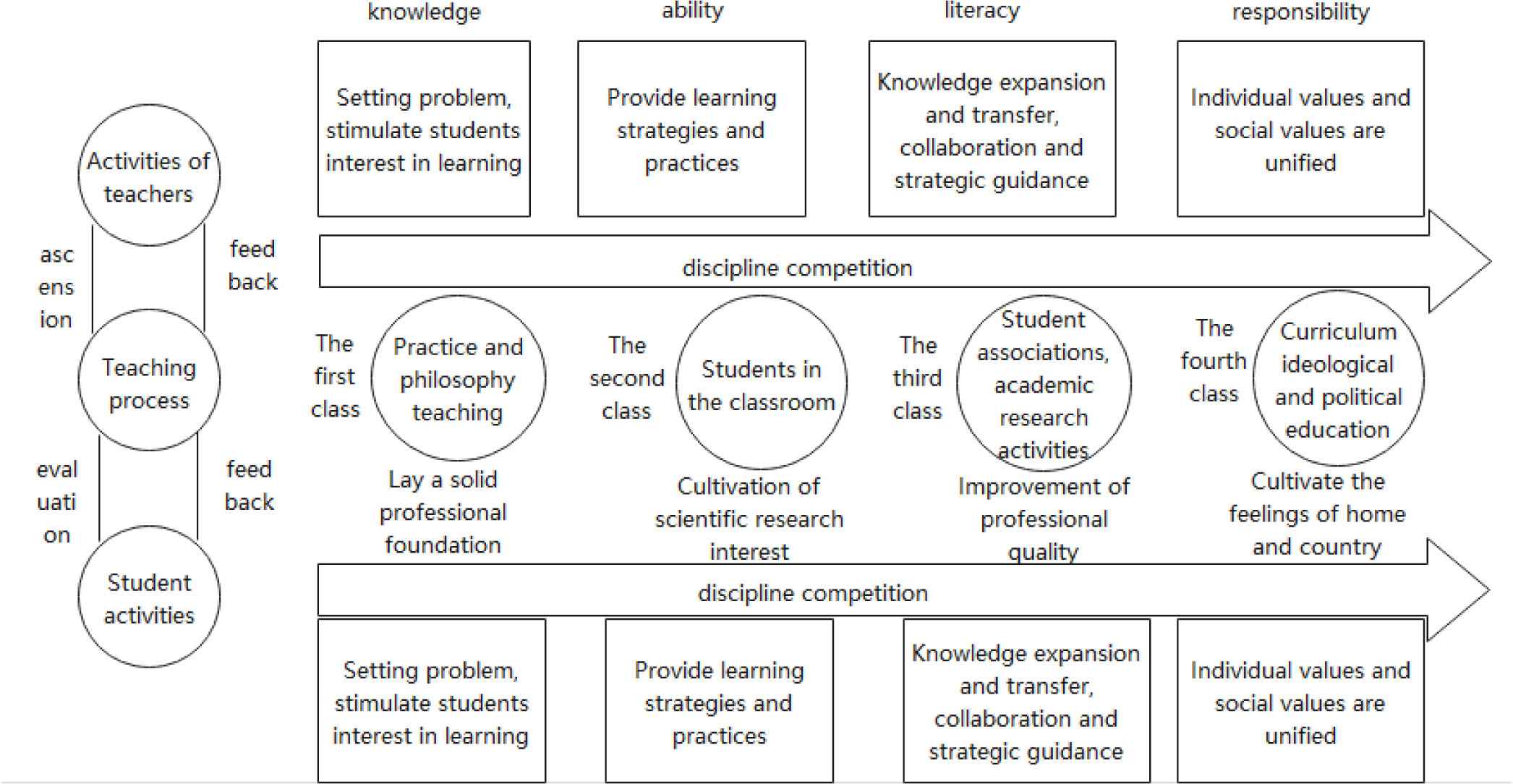
Implementation of innovative practice capability path.
First of all, the way to improve the quality of college students starts with the teaching content and courses of professional innovation demonstration courses based on the first class. In 2020, nearly 500 students in Grade 19 of the School of Computer Science attended the course “Entrepreneurship Foundation” while attending professional courses. Students were required to complete independent learning of professional knowledge, financial management, marketing and other aspects. Later, they completed a complete business plan of product design related to the major through salon guidance [2]. Crisscross auxiliary professional course and demonstration, will learn the book knowledge and the basic theory of three-dimensional, solid professional foundation, and can guide the student to innovation, and integrated use of practice, let students “strong foundation up to”, cultivate students' innovation consciousness and ability unceasingly, this is also the foundation of student discipline competition is knowledge reserves. Then, combined closely with the first class, kechuang studio selection of junior students use their spare time for a freshman students live class, content and technology currently own kechuang projects show the freshman students, cultivating scientific interest as the core aim of the second classroom, and utilization of student associations, academic research activities as the theme of the third class, students' subject contests, Student innovation project and “business plan” and other activities, cultivate students' innovation ability, professional quality. In 2020, the School of Computer Science established the Chenglong Valley Innovation and Entrepreneurship Center. Responsible for the pre-competition training and event organization of discipline competitions, and some scientific research lectures. Students' independent activities stimulate students' enthusiasm to participate in the competition, and strive to improve students' innovative spirit, practical ability, social responsibility, employment ability, and professional development quality, which is also the characteristics of Chenglong Valley as the base construction of the third classroom.
Finally, the ideological and political course (the fourth class) is particularly important in the discipline competition. In the design and training of the competition, students skillfully integrate the ideological and political curriculum, focus on the unity of individual value and social value, pay more attention to the all-round development of individual talents, and emphasize the training of new people who take the responsibility of national rejuvenation, which is the fundamental goal of education to achieve.
2.2. Teaching Design of the Innovative Practice Ability Improvement Path
In the teaching process, teachers, students and teaching process should be paid attention to feedback, evaluation and promotion. Different from other majors, computer major pays more attention to the exchange of project development results and experience. Therefore, to achieve the integration of “creative”, it is necessary to carry out more ingenious design in method design, as shown in Fig. 2. This teaching design is mainly based on action learning, project-based learning and analytical experiential teaching methods, which encourage students to independently complete project selection, team building, project practice and project counseling salon in the process of teaching or competition. Combining the characteristics and advantages of the four classes, Finally, students can complete the four aspects of knowledge reserve, knowledge transfer, internalized knowledge and national responsibility. In the teaching process, students can complete the four aspects of consolidating the foundation, cultivating scientific research interest, improving professional quality and cultivating feelings of home and country. From point to surface, the cultivation and promotion of students' innovation ability are completed layer by layer.
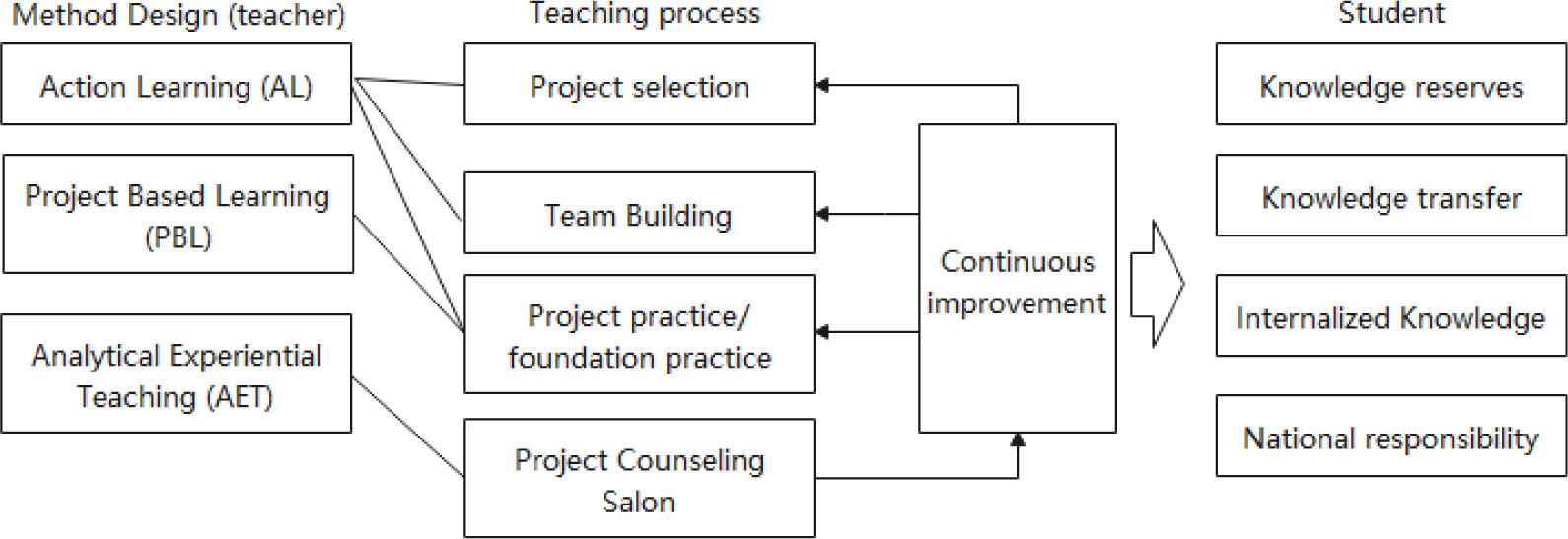
Teaching process design.
3. COMPETITION SELECTION OF THE INNOVATIVE PRACTICE ABILITY PROMOTION PATH
The combination of practical teaching and discipline competition can provide students with diversified ways of learning and development, fully meet the needs of students' innovative learning and independent learning, and better cultivate students' innovative practical ability [3]. Therefore, the selection and design of discipline competition is particularly important [4]. After four years of exploration, the School of Computer Science of Chengdu University organizes students to participate in three kinds of discipline competitions: professional basic competition, comprehensive competition, and scientific and technological innovation competition. The threshold of the basic professional competition is relatively low, and more emphasis is placed on the audience scope, so that more students can join the competition. , the computer comprehensive competition attaches more importance to the application of students' professional knowledge, and has requirements for students' professional application; However, the competition of science and technology innovation pays more attention to the application of students' interdisciplinary subjects, and has higher requirements for students' design innovation. The three kinds of competition in turn put forward higher requirements for students, for the training of students gradually, play a role in improving students' innovative practice ability.
First of all, the major consideration of the basic professional competition is the audience of students. In order to stimulate the enthusiasm of students and avoid students' “daunting” and “retreating from difficulties”, multi-level basic competitions are set up to pay attention to students' participation and help students' multi-dimensional development. The university-level programming competition of Chengdu University has been held four times since 2018, involving nearly 400 students. The event has been “passed down from generation to generation” among students, which has established a certain reputation and brand effect. Set up comprehensive innovative practical teaching courses and big innovation projects, and linked with college, university, provincial and national college students at all levels of discipline competition, enhance students' willingness to participate in the competition, strengthen students' practice and application ability.
Secondly, the comprehensive computer competition is to expand the comprehensive competition on the basis of the basic competition, and pay more attention to the understanding and application of students' comprehensive knowledge. In combination with the campus of Chengdu University Computer College ChengLongGu area B innovation entrepreneurship center – each team studio base training on a regular basis, a line of computer college scientific research students understanding of cutting-edge science and technology, under the guidance of teachers ChengLongGu B area located enterprises lectures and training students appreciate the most advanced technology, and improve students' innovative practice ability and professional quality.
Finally, the main purpose of the science and technology innovation competition is the selection and training of top-notch students. In order to better stimulate the potential of students, the team should be formed to consider the combination of cross-school and multi-disciplinary students. The implementation of long-term effective guidance mechanism, that is, each competition with experienced instructors to guide the whole process; Improve the competition incentive system, that is, the school for outstanding students to reward appropriately.
All in all, according to the individual and growth characteristics of students, choose a different path and the community of science and technology discipline competition, relying on the school practice base, supplemented by courses education, not only provide students with the usual study, experiment and internship opportunities, but also for application of students' comprehensive innovation ability and the cultivation of the home and the feelings created a good environment. This is an important supporting condition for the in-depth development of discipline competition, and also lays flexible classroom for the construction of discipline competition platform. In research discipline problems arising from the competition and development trend, according to the “four classrooms” interaction and promote teaching reform mode, and connecting with the practice teaching link, for discipline competition platform to build up the core of the carrier, this is the change of subject contest and outspread, make subject contest for the innovative talent training service guiding role is more clear, Thus the subject competition and teaching reform achieve a win-win situation [5].
4. CHARACTERISTICS AND INNOVATIONS OF THE PROJECT
The first, second and third classes are organically combined and multi-dimensional evaluation is carried out. See Fig. 3 for details. The evaluation of students' work is not only limited to the first class, but also attaches more importance to the evaluation of students' process, and students can evaluate and evaluate independently. At the same time, the second and third classes evaluate students jointly, and the evaluation system of students is more three-dimensional, scientific and diversified. Break the discipline boundary, combine the original discipline competition and teaching practice of college students, find the best meeting point, establish a diversified incentive mechanism, maximize the potential of each student, and achieve personalized training. By introducing the task and goal of discipline competition, curriculum ideology and politics not only improve the practical innovation ability of college students, but also achieve the final goal of discipline competition, and improve the national mission and national pride of college students.
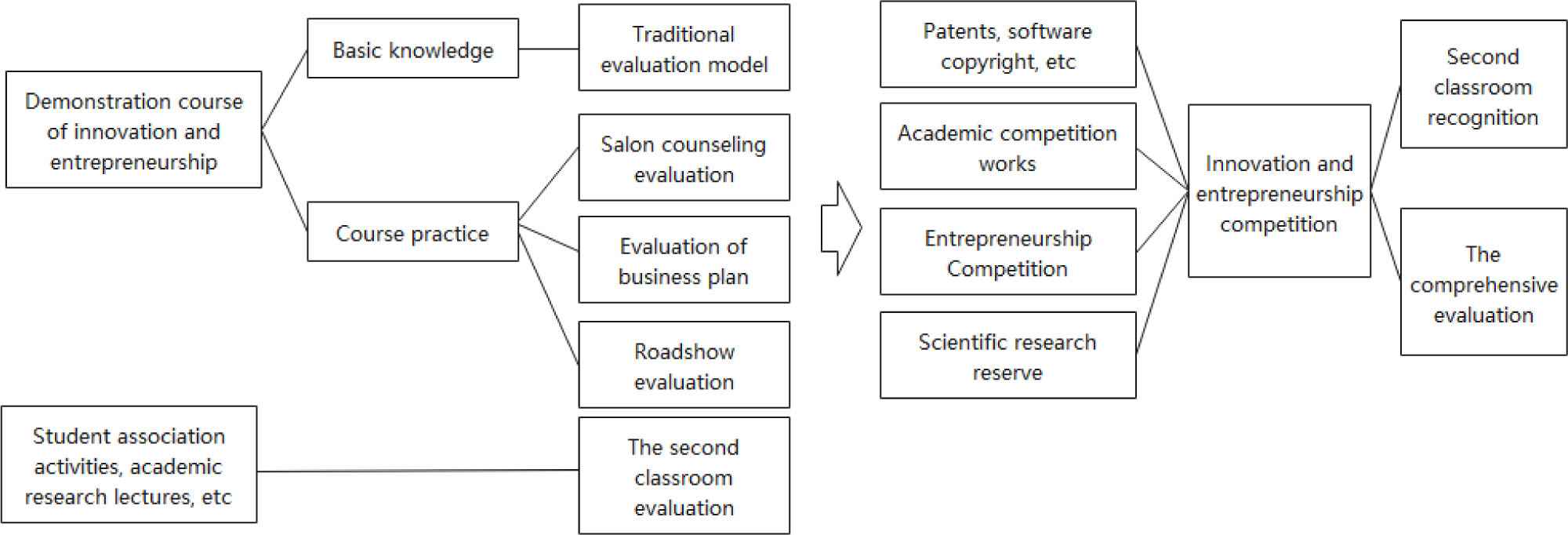
Curriculum evaluation.
5. PATH DESIGN IMPLEMENTATION EFFECT BASED ON THE DISCIPLINE COMPETITION
The path of improving college students' innovative practice ability based on discipline competition has achieved preliminary results. The course “Entrepreneurship Theory and Practice” set up by the School of Innovation and Entrepreneurship of Chengdu University has been adopted in the public compulsory curriculum system of the university and widely used in various discipline competitions. There are 15 incubation projects in Chenglong Valley Zone B, 3 school-level educational reform projects, 5 industry-school cooperation and human resource projects of the Ministry of Education, 5 provincial educational reform projects, several articles on educational reform, a number of patents and software copyright applications, and a number of awards at all levels of competitions. From 2019 to 2021, nearly 300 students majoring in computer science participated in the competition. There were 24 national items in 2019, 115 provincial items, 33 national items in 2020, 143 provincial items, 37 national items in 2021, and 155 provincial items. According to the feedback statistics, It is found that the participation of students in various competitions and the number of awards have increased year by year, as shown in Fig. 4, which also indicates that the popularity of this competition has been established among students, and its influence on students is also increasing.
Shown in Fig. 5, the institute of computer for three years guided students to participate in the “Internet +” contest of college students' innovative undertaking, the national student electronics business “innovation, creativity and entrepreneurship” challenge, Chinese college students computer design contest, contest of college students' innovative undertaking service outsourcing in China and Chinese universities computer competition, won awards 218 items: 21 provincial first prizes, 57 provincial second prizes, 110 provincial third prizes, 1 national first prize, 5 national second prizes and 24 national third prizes.
In 2020, the School of Computer Science began to emerge in the top science and technology competitions. In 2020, the “Challenge Cup” National College Students Extracurricular Academic Science and Technology Works Competition won one provincial gold award. However, there are still some problems in the connection between courses and majors. At present, the School of Computer Science and the School of Innovation and Entrepreneurship have reached an agreement to continue to improve the educational model of “creative” integration.
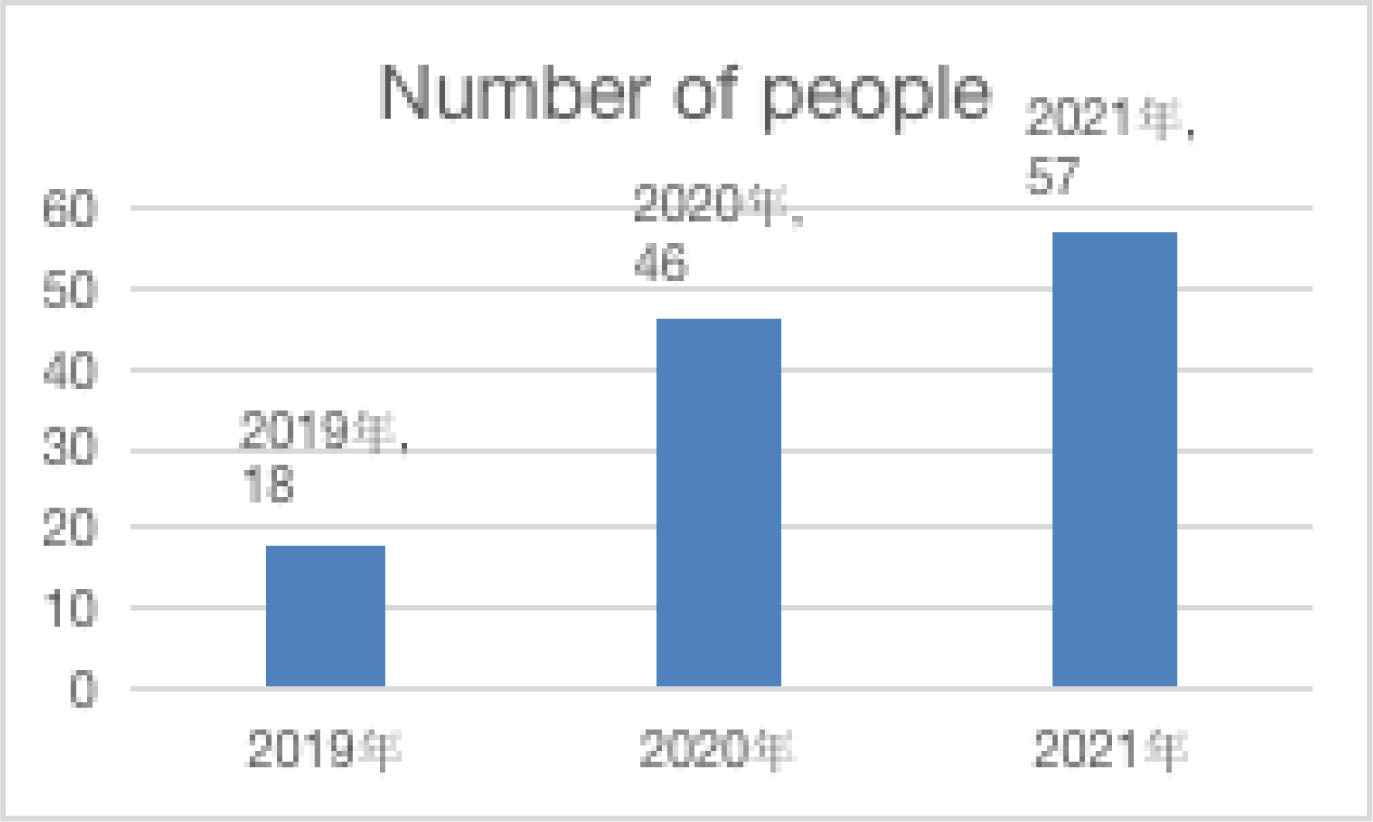
Statistics on the number of winners of the Lanqiao Cup Software Design Competition over the years.
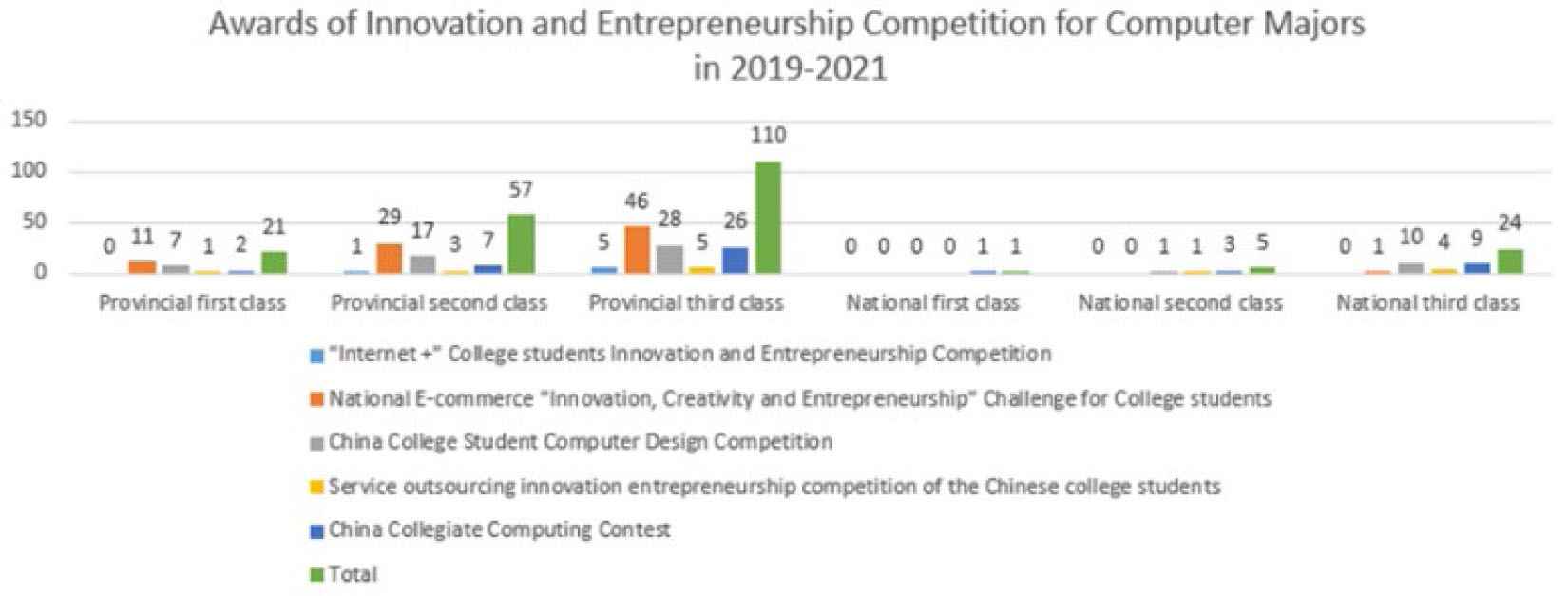
Awards of Innovation and Entrepreneurship Competition for Computer Majors in 2019-2021.
6. CONCLUSION
The clever integration of discipline competition and “innovation and integration” education not only provides students with a platform for scientific research and learning, but also makes up for the shortcomings of existing “innovation and integration”, and significantly improves students' innovation and practice ability, striving to achieve the goal of China's education modernization 2035. In academic competitions, the effect of synergy “four classrooms”, to improve “and” integration of teaching reform mode, pay attention to the practice teaching link, change and extension of “classroom”, make subject contest for innovative entrepreneurial talent training service guiding role is more clear, innovative entrepreneurship teaching four-level implementation, namely: “knowledge - ability - quality - responsibility”. In a word, the path of college students' innovation and practice ability based on discipline competition is an effective way to improve the training quality of innovation and entrepreneurship talents.
ACKNOWLEDGMENT
This article is a research project on the Transformation of Teachers' Roles under the Smart Teaching Model, Chengdu University University-Level Talent Cultivation Quality and Teaching Reform Project in 2022 (project No. cdjgb2022193).
This article is a key project of the Realization mechanism of teachers' In-depth Participation in Innovation and Entrepreneurship education in ordinary undergraduate universities, Chengdu University University-level Talent Training Quality and Teaching Reform project in 2022 (project No. cdjgb2022198) as one of the stage results...
This article sets up a project of Competition-Oriented Innovation and Application Research on Curriculum Construction of Specialized Innovation and Integration Education in Local Undergraduate Colleges and Universities, the 2021 annual project of the New Institute Reform and Development Research Center (No. XJYX2021B03) as one of the stage results.
REFERENCES
Cite This Article

TY - CONF AU - Li Li AU - Xujun Wang AU - Xiujun Zhang PY - 2023 DA - 2023/03/14 TI - Exploration on the Way to Improving College Students' Innovative Practice Ability Based on Subject Competition: Taking the Training of “Specialized and Creative” Talents in Computer Science as an Example BT - Proceedings of the 3rd International Conference on Education Studies: Experience and Innovation (ICESEI 2022) PB - Athena Publishing SP - 31 EP - 37 SN - 2949-8937 UR - https://doi.org/10.55060/s.atssh.230306.006 DO - https://doi.org/10.55060/s.atssh.230306.006 ID - Li2023 ER -









